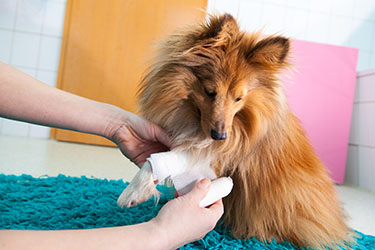Veterinarians: Tips on Treating Burns for Clients

If an animal is hurt and needs first aid care, its injuries may demand immediate attention. When there isn’t enough time to get to a veterinarian, the animal’s family member may need to provide first aid care. In an emergency situation, it’s important that clients know what to do, and are prepared with the right tools to do it.
Client Information about Pet Burns
When shared with clients, the following provides information on injuries caused by burns, and identifies basic first aid care methods to provide for pet treatment.
Identify Severity of Burns
Classifying the severity of a burn injury is determined by the depth of skin damage.
First-degree burn: Superficial burns involving only the top layer of skin
- Skin will appear red and slightly swollen
- Causes minor pain
- Generally heals quickly and won’t require extra care
- Example: mild sunburn.
Second-degree burn: Deep partial thickness wound
- Causes the skin to be blistered and damages the deeper layers of skin
- Increases the risk of infection and tends to take longer to heal
- Extremely painful because the damage to the skin is deeper
- Requires veterinary attention.
Third-degree burn: Full thickness wound
- Damages the entire thickness of the skin, and extends deep into the layer of subcutaneous fat
- Causes the skin to be charred, dry and leathery
- If pulled, the animal’s hair will come out easily
- Creates a loss of sensation
- Animal becomes highly susceptible to a bacterial infection
- Compromises circulation and affects the pet’s electrolyte balance
- Not as painful as a second-degree burn because the nerve endings have been destroyed
- Can be life-threatening and may require intensive care or extensive veterinary care.
First Aid Care for a Pet’s Burn
Superficial burn: If the burn is superficial and involves less than 5% of the animal’s body, the animal can be treated at home by following these steps:
- Apply cool compresses for 20 minutes
- Clip the animal’s coat over the burn area
- Gently wash the skin using an antiseptic wash
- Apply a topical antibiotic ointment
- Wrap a loose, damp gauze dressing around the burn
- The wound should be redressed daily.
Severe burn: When the burn is severe or covers an extensive area of the animal’s body, first aid care can be initiated at home. However, the greater the damage, the higher the chance that the animal will require a level and degree of care that only a veterinarian or emergency room can provide. Animals with severe burns often experience health problems that stem from issues involving:
- Smoke inhalation
- Shock
- Fluid and electrolyte imbalance
- Kidney failure
- Anemia
- Secondary systemic infection.
If it is possible to safely do so, before transporting the severely burned animal to the veterinarian:
- Try to eliminate the chance for further injury by protecting the wound by loosely wrapping the burned area with damp gauze dressing or covering it with a light wet cloth.
Chemical burn: If the burn is caused by chemicals or by contact with chemicals:
- Flush the contact area with water for 10 minutes
- Wearing rubber gloves, bathe the animal with soap and water
- Blot the water off and check for signs of redness or blisters
- Contact the veterinarian.
Emergency First Aid Burn Kit
Having emergency first aid supplies collected and in a location of easy access is essential. In the middle of an emergency, it is important to be able to use the time to focus on providing care for the animal, not on looking for supplies. In the kit, make sure to include the following items that are regularly used for animals with burn injuries.
- Muzzle
- Latex gloves
- Compresses
- Sterile gauze pads, various sizes
- Sterile gauze dressing, various sizes
- Surgical adhesive tape
- Non-adhesive pads
- Scissors
- Surgical antiseptic such as dilute chlorhexidine or Betadine
- Topical antibiotic ointment
- List of emergency phone numbers:
- Veterinarian
- Emergency clinic
- Medical history and shot records of all pets.
When an emergency situation doesn’t allow the time to seek veterinary help, knowing the basics for applying first aid care may ease the animal’s pain and help save its life.
Your Covetrus representative has more information available on providing emergency care, contact us at 855.724.3461.
Careers
Are you looking for a place to let your talents shine? At Covetrus, we help our practitioner customers better serve their patients and take pride in providing the best customer experience possible. Search our open positions to see our available opportunities.
Newsletter
Stay current with what’s going on with Covetrus, subscribe to receive our newsletter and email communications. Subscribers will receive the latest information in practice management, sales and marketing, animal health, and more.


Leave a comment